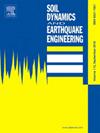基于振动台试验的岩石滑坡和雪崩泥石流冲击柔性屏障的动态响应
IF 4.6
2区 工程技术
Q1 ENGINEERING, GEOLOGICAL
引用次数: 0
摘要
山区通常安装柔性屏障结构,以抵御岩崩的冲击效应。由于缺乏可靠的物理数据,人们对地震激励下岩石滑坡的引发和雪崩泥石流的冲击机理研究仍然知之甚少。本研究建立了岩石斜坡-柔性屏障系统模型,以模拟地震斜坡破坏行为和泥石流对柔性屏障的冲击。在振动台试验中对地震波进行了三轴加载,以有效模拟实际地震响应。结果表明,加速度放大系数(AAF)的响应与上覆岩层的地震破坏和变形密切相关,地震能量在剪切带两侧的不同传播引发了岩崩的发生。此外,在多重地震事件下,模型斜坡的渐进破坏模式是滑移-压缩裂缝破坏。开裂面和滑移面交汇处的挤压扩展是松散断裂岩体的来源。最后,本文研究了大型单体岩块和松散断裂沉积物对柔性壁垒的冲击模式和动态响应。大型块体会对钢丝网造成局部强加速度,增加局部破坏的风险,而松散沉积物则容易引起整体地震变形和支撑结构失稳。揭示了屏障结构的自然震害机理。建议地震多发山区的柔性屏障结构采用合理的基脚设计,以确保柱子在地震活动中能够发生平面外偏转。本文章由计算机程序翻译,如有差异,请以英文原文为准。
Dynamic response of rock landslides and avalanche debris flows impacting flexible barriers based on shaking table tests
Flexible barrier structures are commonly installed in mountainous regions to resist the impact effects of rock avalanches. Without reliable physical data, the study of rock landslide initiation and the impact mechanism of avalanche debris flow under seismic excitation remains poorly understood. In this study, a model of rock slope-flexible barrier system was developed to simulate seismic slope failure behavior and debris flow impact on flexible barriers. Seismic waves in shaking table tests were triaxially loaded to effectively simulate actual seismic responses. The results indicate that the response of the Acceleration Amplification Factor (AAF) is closely associated with seismic damage and deformation within the overlying rock layers and differential propagation of seismic energy on either side of the shear band triggers rockslide initiation. Furthermore, the progressive failure mode of modeled slopes under multiple seismic events is slip-compression cracking failure. Crushing spreading at the intersection of the cracking and slip surfaces is the source of the loose fractured rock mass. Finally, this paper examines the impact patterns and dynamic responses of large individual blocks and loose fractured deposits on flexible barriers. Large blocks cause localized strong acceleration in the steel wire nets, increasing the risk of local damage, whereas loose deposits tend to induce overall seismic deformation and instability of the supporting structure. The natural seismic damage mechanisms of the barrier structure are revealed. It is recommended that flexible barrier structures in earthquake-prone mountainous areas incorporate a reasonable footing design to ensure the columns can deflect out-of-plane in response to seismic activity.
求助全文
通过发布文献求助,成功后即可免费获取论文全文。
去求助
来源期刊

Soil Dynamics and Earthquake Engineering
工程技术-地球科学综合
CiteScore
7.50
自引率
15.00%
发文量
446
审稿时长
8 months
期刊介绍:
The journal aims to encourage and enhance the role of mechanics and other disciplines as they relate to earthquake engineering by providing opportunities for the publication of the work of applied mathematicians, engineers and other applied scientists involved in solving problems closely related to the field of earthquake engineering and geotechnical earthquake engineering.
Emphasis is placed on new concepts and techniques, but case histories will also be published if they enhance the presentation and understanding of new technical concepts.
 求助内容:
求助内容: 应助结果提醒方式:
应助结果提醒方式:


